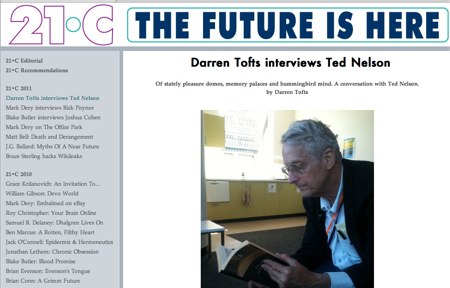Maria Fischer has created an interesting book with links called Traumgedanken (“Thoughts on Dreams”). She has threaded different colored string through the pages, which not only link thoughts and ideas, but also make the links themselves aesthetic objects. They give the work an organic but ethereal appearance that complements the subject matter.
Darren Tofts reports back from an interesting interview with Ted Nelson. Though the interview does focus on some of Nelson’s work, Tofts focuses more on Nelson as a thinker. He suggests that understanding Nelson’s thought patterns might provide us with a better understanding of the hypertext systems he imagines.
I’m not actually that fussed as to whether or not Xanadu ever gets off the ground. In fact I really don’t care. The world is better off for having a character like Nelson who dreamed of something like Xanadu than its technical realization. And in this I’m not being flippant, since the guy has devoted his entire thinking life to it. But for me the idea is far more compelling than the reality. Nelson himself is a larger than life character, so much so that he blurs into metaphysics and brings to mind a host of astonishing historical and fictional entities who have been equally obsessed with, as well as reliant upon, technologies of memory.
Andrè Michelle’s ToneMatrix is a fun little interactive, musical grid . Though not as visually stunning as some of Brian Eno’s work , ToneMatrix invites a different sense of fun and creativity, perhaps brought on by the constraints of the grid.
Clicking on a square adds a tone to a repeating rhythm. The more squares you click, the more complicated the beats become. At first I clicked randomly, then I clicked wildly, then I endeavored to draw interesting things. After drawing a couple of simple shapes and then a panda, I decided that I preferred the sound of non-symmetrical pictures and took great delight in defacing the poor
Michelle has an interesting portfolio of other work, some of which is available for download in the Apple store.
April 8, 2011
Stacey Mason

photo: Jason Carlin
Hollywood’s Weinstein Company, best known for producing such films as Inglorious Bastards and this year’s Oscar-winning The King’s Speech, has decided to try their hand at video games.
Connections have been made between film and games for several years, but I must admit that I’m skeptical here. Movies tell stories by presenting them to the viewer, but games tell stories in a different way. The player must perform the story. Emotion is not elicited through spectating and empathy, but rather putting the player in a situation where she feels the same frustration, guilt, or sense of accomplishment that the protagonist does.
Until creators (and their management) realize this, we’re going to keep getting the terrible movie crossovers to which we’ve become accustomed.
Mark Wernham is currently writing a metaphysical adventure novel called Jefferson Greenspan Saves The Word? But in the midst of writing the novel, he paused to create a narrative iPhone app called “Machine #69,” which contains images, sound, and pieces of the novel including unused backstory and other bits of narrative.
The reason for its existence is the novel I’m currently writing, a metaphysical adventure story called Jefferson Greenspan Saves The Word? which is about time-travelling air conditioning salesman from the future trying to save the world in the 1960s. But the app isn’t an enhanced novel. The novel isn’t even finished, much less published. I describe the app as a ‘fractured digital entertainment experience’, which is jargony and uses the words ‘digital’ and ‘experience’, and indeed ‘fractured’, to suggest that it’s a bit broken, but that it’s something modern and to do with technology […] Or something cool, at any rate. It’s certainly supposed to be a solid 45 minutes or so of immersive (headphones recommended) interaction.
His description offers a bit of insight into his creative process. It also serves as a precedent for other writers to combine paper-novels with hypertext narrative supplementation.
So why did make the app? Partly because it’s the sort of thing I really enjoy doing. One of the attractions of the creative process is the mystery of creation itself; until you make it happen, it doesn’t exist. The more you make something happen, the more it exists.
.





